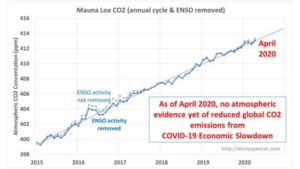by Rotter, from Spencer, May 15, 2020 in WUWT
May 15th, 2020 by Roy W. Spencer, Ph. D.
[UPDATE: MISSING IMAGES INSERTED]
Summary: Atmospheric levels of carbon dioxide (CO2) continue to increase with no sign of the global economic slowdown in response to the spread of COVID-19. This is because the estimated reductions in CO2 emissions (around -11% globally during 2020) is too small a reduction to be noticed against a background of large natural variability. The reduction in economic activity would have to be 4 times larger than 11% to halt the rise in atmospheric CO2.
Changes in the atmospheric reservoir of CO2 occur when there is an imbalance between surface sources and sinks of CO2. While the global land and ocean areas emit approximately 30 times as much CO2 into the atmosphere as humans produce from burning of fossil fuels, they also absorb about an equal amount of CO2. This is the global carbon cycle, driven mostly by biological activity.
…
Fig. 2. Monthly CO2 data since 2015 from Mauna Loa, HI after the average seasonal cycle is statistically removed.
…
…
ADDENDUM: How much of a decrease in CO2 emissions would be required to stop the atmospheric rise in CO2?
An interesting aspect of the observed rise of atmospheric CO2 is that it indicates the greater the CO2 concentration, the faster the “extra” CO2 is removed by biological activity. The observed annual rate of removal is 2.3% of the excess above a baseline of 295 ppm. The greater the “excess”, the faster the rate of removal.
Because of this rapid rate of removal, the anthropogenic CO2 emissions do not have to go to zero to stop the observed rise in atmospheric CO2. Using my simple model (blue line in Fig. 1, above), I find that a 43% reduction in anthropogenic CO2 emissions in 2020 would — in the absence of natural fluctuations in the carbon cycle — lead to a halt in the observed rise of atmospheric CO2 in 2020 over 2019 levels. This is about 4 times larger than the EIA estimate of an 11% reduction in CO2 emissions for the year 2020.

